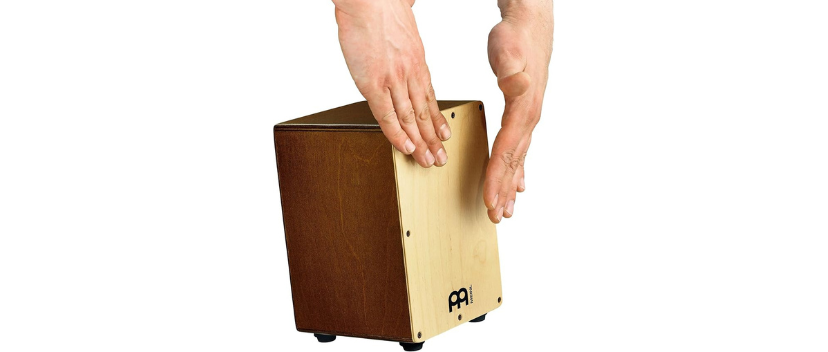In the world of music production, beats are the backbone of countless tracks across various genres,…
How to Play a Mini Cajon

When learning how to play a mini cajon, keep in mind that cajon tones can be varied through playing near its edges for pops and tacks; further up, higher tones; while playing lower down will produce deeper ones.
Relaxing fingers & hands is key for long-term endurance, quality of sound production and reduction of muscle/tendon strains.
Getting Started: How to Play a Mini Cajon
The cajon, or drum box, is an astonishingly versatile percussive instrument. Despite its seemingly simplistic exterior, this percussive instrument contains an abundance of rhythmic potential – making it a mainstay in modern music genres and styles alike. Drummers can further customize their cajon instruments by selecting pedals, cases and seats to meet their personal requirements.
Many percussionists appear to experience arm and hand tension that limits their playing speed and accuracy while increasing muscle and tendon strains and injuries. Therefore, it is crucial that they learn how to play their cajon in a relaxed, comfortable way in order to both increase their quality of playing as well as extend their stamina, reduce injury risks, and maintain good posture for longer.
Begin playing your cajon by sitting comfortably atop it, gently placing your palm flat against its front panel & keeping all fingers in contact with it. Strike the centre of the panel for bass tone & strike its corners for snare drum-like noise; play around with intensity & angle to produce different sounds & rhythms.
Importantly, it should be understood that playing the cajon doesn’t require hard thumping. Doing so may merely mute its sound, leading to poorer quality tones. Furthermore, exerting too much force may aggravate back ache and short or long-term injury risks; your buttocks should ideally sit atop the rear face of the cajon in order to reach playing area of top 6-inches without needing to bend forward in an unnecessary stoop; doing this would be better served by simply being properly aligned against rear face rather than having to bend forward; something which could also relieve back issues while protecting back ache risk factors associated with excessive front pressure could aggravate both conditions.

Specific Mini Cajon Recommendations
The Meinl Travel Cajon is an easily transportable mini-cajon designed for spontaneous jam sessions. Featuring an adjustable bass “sweet spot” and snare wires for full sound reproduction, as well as looking good sitting on any desk or coffee table, it provides great sound at unexpected times!
The Cruz Cajon is an ideal gift idea for both beginners and children, perfect for beginning to learn music or rhythms at an early age! Made to withstand rough handling by children hands, it provides an engaging way for children to engage with rhythms early on while encouraging healthy posture and hand-eye coordination development.
Players looking to bring their cajons on the road have many options available for turning them into bass drums, including pedals that fit directly to the bottom of a cajon and allow drummers to use it just like any regular kick drum with foot pedals. Some pedals even allow musicians to mount hi-hats or other percussion instruments onto them for even more possibilities!
Other cajon accessories, like bags and seats, make long gigs more manageable by providing musicians a space to rest their arms during performance – helping them remain focused on music without becoming fatigued as quickly.
Pedals enable drummers to emulate a bass drum, freeing their hands for more complex rhythms or simultaneous instrument playing. Pedals can especially come in handy for cajon players in quieter venues or acoustic bands.
The ChromaCast Cajon Pedal was developed specifically by drummers for drummers. Featuring its durable double-action pedal steel swing system for increased speed while still offering professional feel and responsiveness, you’re able to set this pedal to suit your playing style thanks to a spring adjustment system.
Techniques for How to Play a Mini Cajon
Our Key Advice: It is of utmost importance that you gain a firm grasp on your cajon drum and find your groove when playing it. In order to do so successfully, playing along with familiar songs is highly beneficial as this allows you to get used to its sounds while at the same time exploring how they fit with its rhythmic beat.
Cajon techniques vary, but all players use certain fundamental beats & strokes that all use, most notably the bass stroke – hitting the centre of the front face of your cajon with your dominant hand palm to create a low tone resembling that produced by a bass drum on a drum set.
Corner Techniques
Another technique is creating high tones on a cajon tapa face using one, two, or three fingers to hit its corners with. The sound produced is more woody than typical snare drum percussion (though snare can still be used), providing another useful tone depending on musical context and requirements.
The bass stroke and high tone cajon beats are essential cajon components that appear in many styles of music. When performing these beats, be sure to do it consistently and with equal intensity as any other cajon beat in order to ensure an integrated, professional sound from your cajon ensemble.
Utilizing these basic beats will provide the foundation that allows you to perform more complex cajon music & collaborate with other musicians in a live setting. Experimentation with different techniques & tonality of your cajon will help you develop your own style & persona over time.
Other ways of improving your cajon skills include experimenting with brushes on the front face of the tapa and altering its angle of attack/contact to produce different tones. You could also experiment with playing nearer/further from edges to achieve different tones (playing closer produces more ‘pop’ with less snare sound while further from edges creates deeper tones). You could also play around with hitting force: lighter touches create ghost notes which motivate dancers and encourage interaction with your music.
Rhythms
A cajon is a wooden musical box which, when hit in certain ways and locations, can produce drum-like sounds when hit. Used to replace traditional drum kits or add unique sounds to bands. Cajons have often been called “drum kits in a box,” as they produce all three basic kick, snare and hi-hat sounds found on conventional sets.
Cajon players typically employ bass beats and high-to-low strokes that fill in the groove as their primary rhythmic patterns. As you become more proficient, try adding in slap strokes and touch strokes as additional variations to create various sounds and beats.
Incorporating the Bass Beat
The bass beat is one of the crucial aspects of how to play a mini cajon. Start playing bass beats by placing your left foot on the back two-thirds of the cajon and placing your right foot on its front two-thirds; this will help ensure that you sit up straight when playing and will help build coordination for playing bass beats.
As you practice bass beats on a cajon, try hitting the top face rather than its sides or corners for optimal bass sound and to ensure clear separation between snare and bass beats. Bass sounds can often go neglected without much consideration given to them; yet their sound has the power to drastically transform how the instrument sounds and is played.
One effective method for developing your sense of the bass stroke is playing along with a song and listening closely to how the bass sounds on your instrument. If you can clearly hear and match up strikes with beats in song, this will help develop your understanding of this essential component of the instrument.
The touch stroke is similar to the slap stroke in that it uses fingers to strike the upper face of a cajon; however, its force is much lighter. Cajon players use it as fill-in stroke or can combine it with other strokes for unique sounds and strengthening finger strength and flexibility.
Summary of How to Play a Mini Cajon
When purchasing a cajon, it’s essential that you take the time and care to select one that meets all of your needs. Consider various factors including its intended use; mic’d up versus unmic’d operation; high or low toned option and which brand it comes from – these will all play an integral part.
Don’t be persuaded by advertising or branding tactics alone; rather base your decision purely on key factors discussed here that will bring years of pleasure & satisfaction from this amazing instrument!



